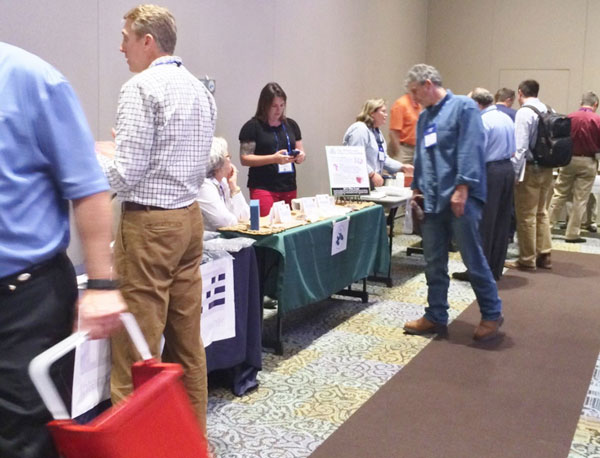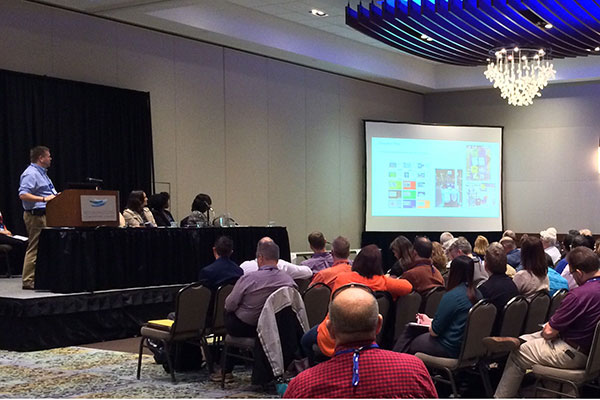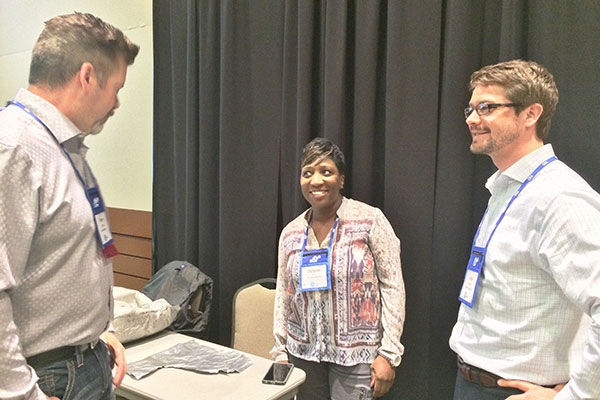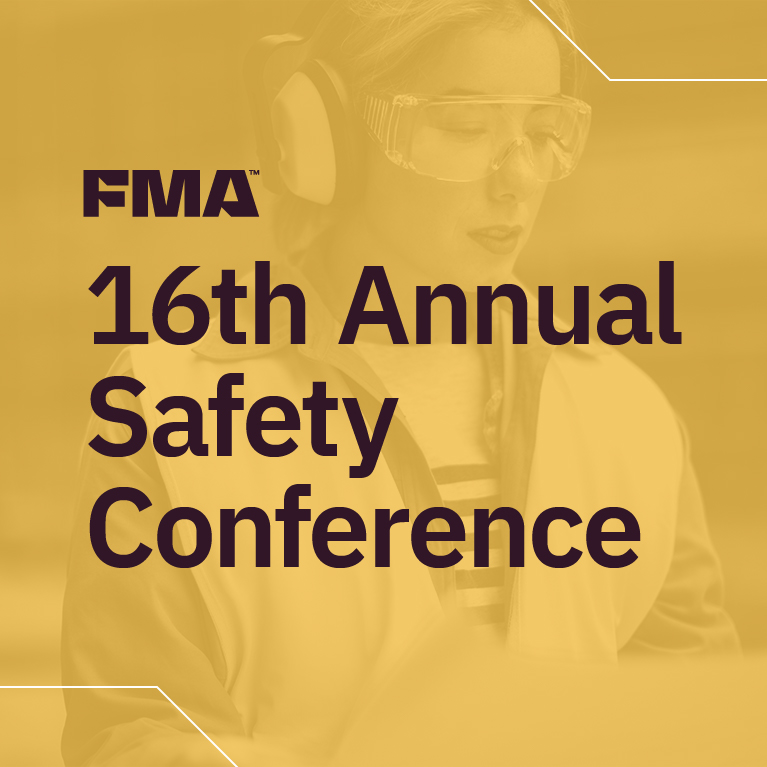Carolina Manufacturers Zero Out Waste at Conference
By Kate Bachman | April 12, 2016
Category:
One of the more unique aspects of the Manufacturers Zero Waste Conference was its “zero waste flea market” at which manufacturers had the opportunity to exhibit by-product waste materials to sell to recycling vendors and other manufacturers.
Manufacturers of all sizes—giants among them—shared successes and challenges at the Manufacturers Zero Waste Conference in Wilmington, N.C., held March 22 to 23.
Unilever, Bridgestone, Caterpillar, BMW, Kimberly-Clark, Timken, Honda of South Carolina Mfg., Grifols, Leggett & Platt, Daimler Trucks North America, Borg Warner, Westinghouse, PRC, CertainTeed, Whole Foods, and other North Carolina and South Carolina manufacturers relayed winning strategies, offered advice, commiserated about some of the challenges they face—and energized their waste reduction and zero waste initiatives.
Co-hosted by the Carolina Recycling Association (CRA), co-located with its annual tradeshow, and in collaboration with North Carolina and South Carolina environmental agencies*, the conference facilitated peer-sharing among more than 100 manufacturers pursuing zero waste to landfill—and exchanges between manufacturers seeking outlets for their waste by-products and recyclers seeking to purchase waste materials.
Unilever Global R&D Packaging Sustainability Manager Julie Zaniewski and Bridgestone Americas Director of Environmental Management Greer Tidwell keynoted the event.
Tidwell relayed how the manufacturer achieved its UL Environment-certified zero landfill accomplishments at two of its plants, highlighted in Sustainable Manufacturer Network’s article, “For Bridgestone’s sustainability, zero landfill is where the rubber meets the road.”
Zaniewski provided Unilever’s global perspective on why sustainability is at the core of its motto, make sustainable living commonplace. “Soon we’ll have 9 billion people on the planet, and we’ll all have to live on it,” she said. (Look for more about Unilever’s sustainability initiatives in an upcoming issue.)
Sage Advice from Zero-wasters
It was “standing room only” for some during the Zero Waste to Landfill 101 session. The peer-sharing and expert presentations netted some sage advice to manufacturers in pursuit of zero landfill.
“We all, here, have a personal commitment to protecting the environment,” said Ryan Pennington, of Freightliner Custom Chassis Corp. (FCCC), one of the session speakers. FCCC, a Daimler Trucks North America company, achieved zero waste to landfill in 2009. (Read more about the manufacturer’s achievement, “Chassis builder achieves zero waste to landfill using reusable packaging.”)
How to Get Staff Buy-in. “Recruit volunteers across the company for your green team to get commitment,” Pennington said. “Make sure the team is involved in the whole process so they have ownership,” he added. “Develop friendly competition among divisions,” he suggested, giving examples of site-to-site competitions to recycle the most by-products.
Wes Westbrooks, BMW, said “Our biggest champions are our associates on the floor. Listen five minutes a day, and you’ll get good feedback. Westbrooks also said that getting top-to-bottom involvement is key to a successful program. “We had company executives doing a dumpster dive. That was great for morale and buy-in.”
How to Establish a Baseline. “You really have to do a dumpster dive to establish your baseline,” advised Stacey Washington, for the S.C. Department of Health and Environmental Control (DHEC). Washington assisted FCCC with its zero landfill initiative. “You have to examine where you are before you can set your goals. If you’re going zero, you need to look at everything.”
“You’ll find many items in the trash that you think you’re recycling,” Sandra Carter, of Daimler Trucks North America, concurred.
Simplifying Recyclables Collection. Diane Joyner, environmental engineer, Westinghouse, described how co-locating trash and recycling collection areas and segregating at the source helped the company cut its landfill waste from 50 tons a month in 2008 to 13.3 tons a month in 2015. “The trash containers used to be closer and easier to use. Now they’re located together.”
In pursuit of zero landfill, Westinghouse is initiating a capital expenditure for an on-site composter. “That should cut our food and paper products waste in half,” Joyner said.
Jan Foster of Waste Reduction Partners also offered guidance on how to improve recycling and returns on it. “Signage on recycling receptacles should be color-coded, and it’s better to show what can go in rather than what cannot,” she advised.
How to Reduce Waste Generation. Westbrook shared some of BMW’s strategies for reducing waste generated.
One reduction project centers around its metal recycling. By maximizing loads for transportation efficiency and better type segregation, the company is increasing its refund. Another is to recycle its purge solvent. The company explored on-site options and concluded that it is better to send it out for recycling because it does not change its constitution and generates a profit—“a win-win.”
Data analysis shows that the automaker is paying more than $75,000 a year for wood pallets and generating 13 million pounds of waste. “This represents a major opportunity for cost reduction and a balanced relationship,” he said. BMW is exploring options, including installing a stationary wood grinder and using the ground wood for boiler fuel, fuel cubes, and mulch.
Foster also offered successful strategies germane to manufacturing operations and equipment.
“Can you update your powder coating equipment to reduce overspray? Can you use returnable packaging, racking, and crates? That represents the biggest potential for cost savings,” she said.
Sharing Challenges, Solutions
Almost all of those in attendance had “problem waste streams,” including sludge, polystyrene, laminated materials, cafeteria waste, nitrile gloves, slick labels, bathroom paper towels, electronic monitors, construction debris, and recyclable materials in too-small quantities to attract recycler pickups.
Waste Flea Market. One of the more ingenious aspects of the event to help with difficult-to-outlet wastes was a “zero waste flea market (see lead image). Attendees brought samples of their problem wastes to display at tabletops and other manufacturers and recycling vendors from the adjoining CRA tradeshow conferred with them about wanting to buy them.
Milk Runs. To help resolve problems with small quantities, Jan Foster of Waste Reduction Partners suggested. “Reach out to other manufacturers to establish ‘milk routes’ for waste that you accumulate in too small quantities to garner a trip from a recycler.” Many of those in attendance said that they had established such co-collections with neighboring manufacturers.
Networking. Several speakers advised fellow manufacturers to work within a network for help and support. (We’d love it if you would join Sustainable Manufacturer Network.)
Low Oil Prices, Low Recycling Returns. PRC Industries’ Dan Frisbee lamented the downside of current gas prices. “You know how you like filling up your car’s tank so cheaply? That cheap oil means that the value of recycled plastics has tanked also, making it harder to sell your recycled plastics.”
Low returns are not the only problem some manufacturers are encountering. In some cases, they cannot find recyclers to take certain materials at all. One attendee asked the group whether others were experiencing a shortage of recyclers who would accept glass byproducts.
Waste Exchange Tools. As the number of manufacturers pursuing zero waste to landfill grows, waste exchange sites and services have proliferated. The S.C. DHEC calls its waste match-making service Materials Exchange and N.C. Department of Environmental Quality’s is called Waste Trader. These free services to help organizations divert waste from landfills by facilitating the exchange of reusable discarded and surplus materials.
Changes Everything
One common theme sounded throughout all of the presentations was that declaring zero waste to landfill has had a profound effect on the manufacturers’ operations and business models.
Most of the presenters nearing or at their zero landfill goals expressed how influential the experience has been to them and their companies.
“Sustainability has completely changed the way we manufacture everything,” John Janes of Caterpillar said emphatically. It has changed the paint materials we use, the adhesives we use … our entire operations.”
Reducing by-product materials intensity by 50 percent en route to zero waste to landfill is part of Caterpillar’s Vision 2020 strategy. Out of the global giant’s plants, at least 154 have reached–and are sustaining—a 90 percent waste reduction rate or better.
“At PRC, considering the environment has changed the way we work, play, and live,” Frisbee said.
“Our journey to zero landfill changed the entire company culture,” Pennington added.
……………
*State agencies involved with planning the event were the N.C. Department of Environmental Quality (NCDEQ), N.C. Division of Environmental Assistance and Customer Service (DEACS); S.C. Department of Health and Environmental Control (DHEC); and the S.C. Department of Commerce (DOC).

Side by side, we move metal fabrication forward.
FMA unites thousands of metal fabrication and manufacturing professionals around a common purpose: to shape the future of our industry, and in turn shape the world.
Learn More About FMA


